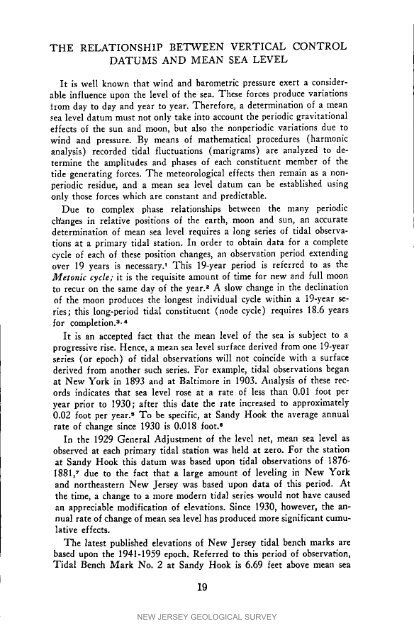NJDEP - NJGS - Bulletin 66, Mapping Digest for New Jersey, 1965
NJDEP - NJGS - Bulletin 66, Mapping Digest for New Jersey, 1965
NJDEP - NJGS - Bulletin 66, Mapping Digest for New Jersey, 1965
You also want an ePaper? Increase the reach of your titles
YUMPU automatically turns print PDFs into web optimized ePapers that Google loves.
THE RELATIONSHIP BETWEEN VERTICAL CONTROLDATUMS AND MEAN SEA LEVELiIt is well known that wind and barometric pressure exert a considerableinfluence upon the level of the sea. These <strong>for</strong>ces produce variationsilom day to day and year to year. There<strong>for</strong>e, a determination of a meansea level datum must not only take into account the periodic gravitationaleffects of the sun and moon, but also the nonperiodlc variations due towind and pressure. By means of mathematical procedures (harmonicanalysis) recorded tidal fluctuations (marlgrams) are analyzed to determinethe amplitudes and phases of each constituent member of thetide generating <strong>for</strong>ces. The meteorologlcal effects then remain as a nonperiodicresidue, and a mean sea level datum can be established usingonly those <strong>for</strong>ces which are constant and predictable.Due to complex phase relationships between the many periodicclfanges in relative positions of the earth, moon and sun, an accuratedetermination of mean sea level requires a long series of tidal observationsat a primary tidal sratlon. In order to obtain data <strong>for</strong> a completecycle of each of these position changes, an observation period extendingover 19 years is necessary) This 19-year period is referred to as themetonic cycle; it is the requisite amount of time <strong>for</strong> new and full moonto recur on the same day of the year. 2 A slow change in the declinationof the moon produces the longest individual cycle within a 19-year series;this long-period tidal constituent (node cycle) requires 18.6 years<strong>for</strong> completlon. 3.4It is an accepted fact that the mean level of the sea is subject to aprogressive rise. Hence, a mean sea level surface derived from one 19-yearseries (or epoch) of tidal observations will not coincide with a surfacederived from another such series. For example, tidal observations beganat <strong>New</strong> York in 1893 and at Baltimore in 1903. Analysis of these recordsindicates that sea level rose at a rate of less than 0.01 foot peryear prior to 1930; after this date the rate increased to approximately0.02 foot per year. 5 To be specific, at Sandy Hook the average annualrate of change since 1930 is 0.018 foot. aIn the 1929 General Adjustment of the level net, mean sea level asobserved at each primary tidal station was held at zero. For the stationat Sandy Hook this datum was based upon tidal observations of t876-18817 due to the fact that a large amount of leveling in <strong>New</strong> Yorkand northeastern <strong>New</strong> <strong>Jersey</strong> was based upon data of this period. Atthe time, a change to a more modern tidal series would not have causedan appreciable modification of elevations. Since 1930, however, the annualrate of change of mean sea level has produced more significant cumulativeeffects.The latest published elevations of <strong>New</strong> <strong>Jersey</strong> tidal bench marks arebased upon the 1941-1959 epoch. Referred to this period of observation,Tidal Bench Mark No. 2 at Sandy Itook is 6.69 feet above mean sea19NEW JERSEY GEOLOGICAL SURVEY
















